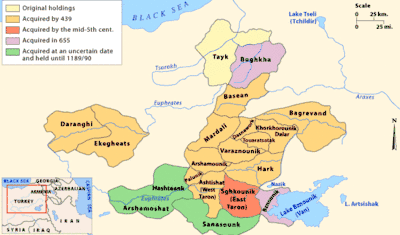Battle of Bagrevand (372)
Battle of Bagrevand, also called the Battle of Bagavan[2] or the Battle of Vagabanta[3], was fought in 372, on the plain of Bagrevand, with the Roman-Armenian armies defeating the Persian forces.[4]
| Battle of Bagrevand | |||||||
|---|---|---|---|---|---|---|---|
 | |||||||
| |||||||
| Belligerents | |||||||
| Sassanid Empire |
Roman Empire Kingdom of Armenia | ||||||
| Commanders and leaders | |||||||
|
Shapur II Urnayr |
Traianus Vadomarius Mushegh I Mamikonian | ||||||
Background
In 369 CE, Shapur II, Shah of the Persian Sassanid Empire, persuaded the Armenian King, Papas (Pap) to change his allegiance. Under Shapur's influence Papas murdered the Cylaces and Artabanes and sent their heads to the shahanshah as a sign of loyalty. The Emperor of the Eastern Roman Empire, Valens, sent one of his generals, Arintheus, with an army into Armenia and Pap immediately reverted to his earlier loyalty to Rome.
In the winter 370 Shapur decided to settle the Armenian matter by force; he declared the Treaty of 363 (a thirty year peace agreement between the Persians and the Romans) to be void and began amassing an army to invade Armenia during the next spring.
Learning of the impending attack, Papas ordered a muster be held at Barevand. The Romans, under the command of Valens' generals Traianus and Vadomarius, had armies at Erhand and Baxish. They also marched for Bagrevand and build a fortified camp while they waited for the Armenians to assemble. Eventually, the Armenians mustered an army of 90,000 men. It was decided that the Sparapet (general) Mushegh I Mamikonian would command the Armenian forces while the Romans remained under their own command.
Battle
The combined Armenian-Roman army met the Persian force not far from a village called Dzirav (near Bagrevand) and were victorious. Apparently the Armenians broke the Sassanid battle lines and causing a route. Faustus of Byzantium gives considerable credit for the victory to sparapet Mushegh I Mamikonian. Movses Khorenatsi of Armenia and Roman historian Ammianus Marcellinus noted that the Valens' generals did not actively participate in the battle, but rather were engaged in protecting the king. During the ensuing battles more Armenian territories were reclaimed from the Sassanids, including Arzanene and Corduene which were ceded to Persians by Jovian in 363.
Aftermath
Although he lost the Battle of Barevand, Shapur was determined not to give in. The Sassanid Shah launched several minor invasions and raiding parties into Armenian territory, before another major assault led to a second battle at Gandzak.[5] At the Battle of Gandzak the Roman-Armenian army defeated the Sassanids for the second time that year. After the battle Shapur sent envoys and a truce was agreed upon. The truce would last for seven years.[6]
References
- "ARMENIA AND IRAN ii. The pre-Islamic period – Encyclopaedia Iranica". www.iranicaonline.org. Retrieved 2019-08-23.
In 372 Šāpūr again marched into Armenia, but the Roman forces, supported by Armenian contingents, decisively defeated the Persians in a battle at Bagavan, on the Arsanias river at the foot of Mount Niphates.
- Ian Hughes, Imperial Brothers, p. 102.
- Ammianus Marcellinus, Res Gestae, 29.1.3.
- "ARMENIA AND IRAN ii. The pre-Islamic period – Encyclopaedia Iranica". www.iranicaonline.org. Retrieved 2019-08-23.
In 372 Šāpūr again marched into Armenia, but the Roman forces, supported by Armenian contingents, decisively defeated the Persians in a battle at Bagavan, on the Arsanias river at the foot of Mount Niphates .
- Ammianus Marcellinus, Res Gestae, 29.1.4.
- Ian Hughes, Imperial Brothers, p. 106.